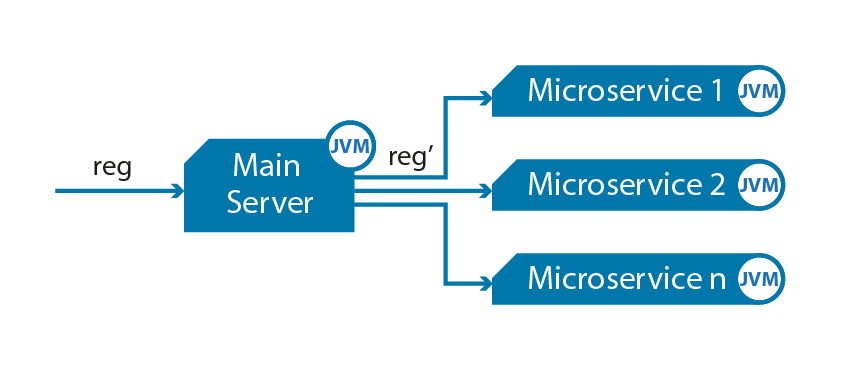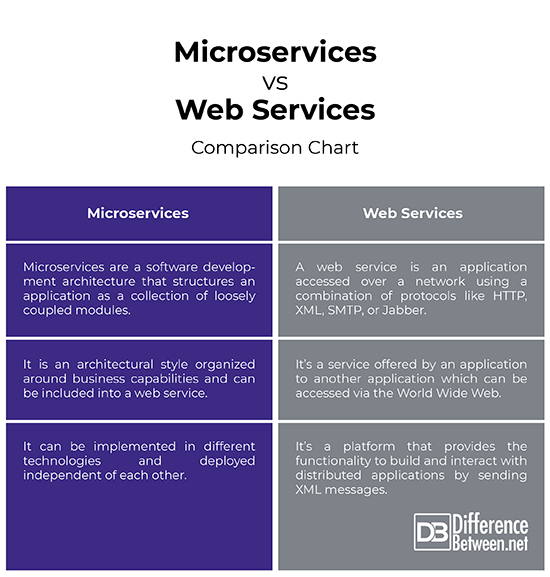Difference Between Microservices and Web Services
For years, we have been working to find better ways to build systems. We’ve been learning from what has come before, trying to adopt new technologies as they come. Technology-oriented companies keep on adopting new technologies and operating in many different ways to create IT systems that make their customers happier. Our understanding of how the Web works has led us to develop better ways to build systems that are more efficient in every way possible. Microservices was born from this world – they emerged as a trend from real-world use. Sometimes, big things come is small packages. This is certainly the case with microservices.
Microservices are small, autonomous services that work together. They are a new approach to modularization of software, which is not a new concept. They are independent processes that communicate with each other to accomplish a task within a much larger application. With microservices, businesses are able to adopt new technology more quickly and effectively than ever. Web services are any service that is available over the internet and is built using standard internet technologies. A web service is not tied to any operating system or programming language, and uses a standardized XML messaging system. This article gives more details about the two concepts and the difference between the two.

What is Microservices?
Microservices, also known as microservices architecture, are a software development architecture that structures an application as a collection of loosely coupled modules. It can be implemented in different technologies and deployed independent of each other. This means changes in one microservice can be taken into production independently so that changes won’t affect other microservices. The idea is to divide large software systems into smaller parts. With microservices, you can make a change to a single service and deploy it independently of the rest of the system. This helps you get your code deployed faster. And if a problem does occur, it can be isolated quickly to an individual service, making rollback fast and easy. This is probably the reason why companies like Netflix and Amazon use these architectures.

What is Web Services?
A web service is a network accessible interface to application functionality that helps expose the functionality of an application to another application. It is built using standard internet technologies. It’s a platform that provides the functionality to build and interact with distributed applications by sending XML messages. In simple terms, a web service is an application accessed over a network using a combination of protocols like HTTP, XML, SMTP, or Jabber. As a whole, web services represent the evolution of principles that have guided the internet for years. They represent a new architectural paradigm for applications. They implement capabilities that are available to other applications via industry standard network and application interfaces and protocols.
Difference between Microservices and Web Services
-
Basics of Microservices and Web Services
– Both Microservices and Web Services are application development architecture for building and deploying software applications, but they differ in their development style. Microservices are a software development architecture that structures an application as a collection of loosely coupled modules. It can be seen as a lightweight service-oriented architecture (SOA). Web services, on the other hand, are a network accessible interface to application functionality that helps expose the functionality of an application to another application. A web service is an application accessed over a network using a combination of protocols like HTTP, XML, SMTP, or Jabber.
-
Architecture of Microservices and Web Services
– Microservices, also known as the microservice architecture, is an architectural style mainly organized around business capabilities and priorities. It’s an approach to modularization of software in which large systems have been divided into small modules to facilitate the implementation, understanding, and further development of the software. Web services, on the other hand, represent a new architectural paradigm of applications which can be seen as lightweight service-oriented architecture. It’s an interoperability architecture that identifies the elements of web services network required to ensure interoperability between web services.
-
Function
– Microservices are a set of small self-sustained small services or applications designed to solve problems for systems that are big. The systems are divided into small modules to facilitate the implementation, understanding, and development of the software. It allows you to work independently on these modules, which you are then able to test and deploy. A web service allows applications to be integrated more rapidly and easily than ever before. It facilitates direct application-to-application interaction using internet protocols and standards, thereby reducing the cost of doing e-businesses.
-
Structure of Microservices and Web Services
– Microservices is an architectural style organized around business capabilities and can be included into a web service. However, microservices can be any service implemented as an independent function that has its own database and can be deployed independent of each other. A web service acts as an abstraction layer that separates the platform and programming-language-specific details of how the application code is actually invoked. It’s a way of API representation through HTTP. It’s a service offered by an application to another application which can be accessed via the World Wide Web.
Microservices vs. Web Services: Comparison Chart

Summary of Microservices Vs. Web Services
Microservices are small, autonomous services that work together, while web services are any service that is available over the internet and is built using standard internet technologies. Microservices are a set of small self-sustained small services or applications designed to solve problems for systems that are big. If an application is accessed over a network using a combination of protocols like HTTP, SMTP, XML, or Jabber, then it is a web service. Web services are not a new concept. In fact, they represent the evolution of principles that have guided the Internet for years.
- Difference Between Caucus and Primary - June 18, 2024
- Difference Between PPO and POS - May 30, 2024
- Difference Between RFID and NFC - May 28, 2024
Search DifferenceBetween.net :
Leave a Response
References :
[0]Image credit: https://upload.wikimedia.org/wikipedia/commons/thumb/1/1d/AmazonWebservices_Logo.svg/500px-AmazonWebservices_Logo.svg.png
[1]Image credit: https://commons.wikimedia.org/wiki/File:JLupin_wiki_fig3.png
[2]Webber, James and Sandeep Chatterjee. Developing Enterprise Web Services: An Architect's Guide. New Jersey: Prentice Hall, 2004. Print
[3]Snell, James, et al. Programming Web Services with SOAP. Sebastopol, California: O’Reilly Media, 2001. Print
[4]Wolff, Eberhard. Microservices: Flexible Software Architecture. Boston, Massachusetts: Addison-Wesley, 2016. Print
[5]Newman, Sam. Building Microservices. Sebastopol, California: O’Reilly Media, 2015. Print
